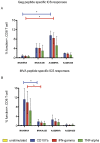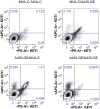Heterologous prime-boost regimens using rAd35 and rMVA vectors elicit stronger cellular immune responses to HIV proteins than homologous regimens
- PMID: 23049876
- PMCID: PMC3458867
- DOI: 10.1371/journal.pone.0045840
Heterologous prime-boost regimens using rAd35 and rMVA vectors elicit stronger cellular immune responses to HIV proteins than homologous regimens
Abstract
We characterized prime-boost vaccine regimens using heterologous and homologous vector and gene inserts. Heterologous regimens offer a promising approach that focuses the cell-mediated immune response on the insert and away from vector-dominated responses. Ad35-GRIN/ENV (Ad35-GE) vaccine is comprised of two vectors containing sequences from HIV-1 subtype A gag, rt, int, nef (Ad35-GRIN) and env (Ad35-ENV). MVA-CMDR (MVA-C), MVA-KEA (MVA-K) and MVA-TZC (MVA-T) vaccines contain gag, env and pol genes from HIV-1 subtypes CRF01_AE, A and C, respectively. Balb/c mice were immunized with different heterologous and homologous vector and insert prime-boost combinations. HIV and vector-specific immune responses were quantified post-boost vaccination. Gag-specific IFN-γ ELISPOT, intracellular cytokine staining (ICS) (CD107a, IFN-γ, TNF-α and IL-2), pentamer staining and T-cell phenotyping were used to differentiate responses to inserts and vectors. Ad35-GE prime followed by boost with any of the recombinant MVA constructs (rMVA) induced CD8+ Gag-specific responses superior to Ad35-GE-Ad35-GE or rMVA-rMVA prime-boost combinations. Notably, there was a shift toward insert-focus responses using heterologous vector prime-boost regimens. Gag-specific central and effector memory T cells were generated more rapidly and in greater numbers in the heterologous compared to the homologous prime-boost regimens. These results suggest that heterologous prime-boost vaccination regimens enhance immunity by increasing the magnitude, onset and multifunctionality of the insert-specific cell-mediated immune response compared to homologous vaccination regimens. This study supports the rationale for testing heterologous prime-boost regimens in humans.
Conflict of interest statement
Figures






References
-
- Rerks-Ngarm S, Pitisuttithum P, Nitayaphan S, Kaewkungwal J, Chiu J, et al. (2009) Vaccination with ALVAC and AIDSVAX to prevent HIV-1 infection in Thailand. N Engl J Med 361: 2209–2220. - PubMed
-
- Lu Y, Ouyang K, Fang J, Zhang H, Wu G, et al. (2009) Improved efficacy of DNA vaccination against prostate carcinoma by boosting with recombinant protein vaccine and by introduction of a novel adjuvant epitope. Vaccine 27: 5411–5418. - PubMed
-
- McConkey SJ, Reece WH, Moorthy VS, Webster D, Dunachie S, et al. (2003) Enhanced T-cell immunogenicity of plasmid DNA vaccines boosted by recombinant modified vaccinia virus Ankara in humans. Nat Med 9: 729–735. - PubMed
Publication types
MeSH terms
Substances
LinkOut - more resources
Full Text Sources
Other Literature Sources
Medical
Research Materials

